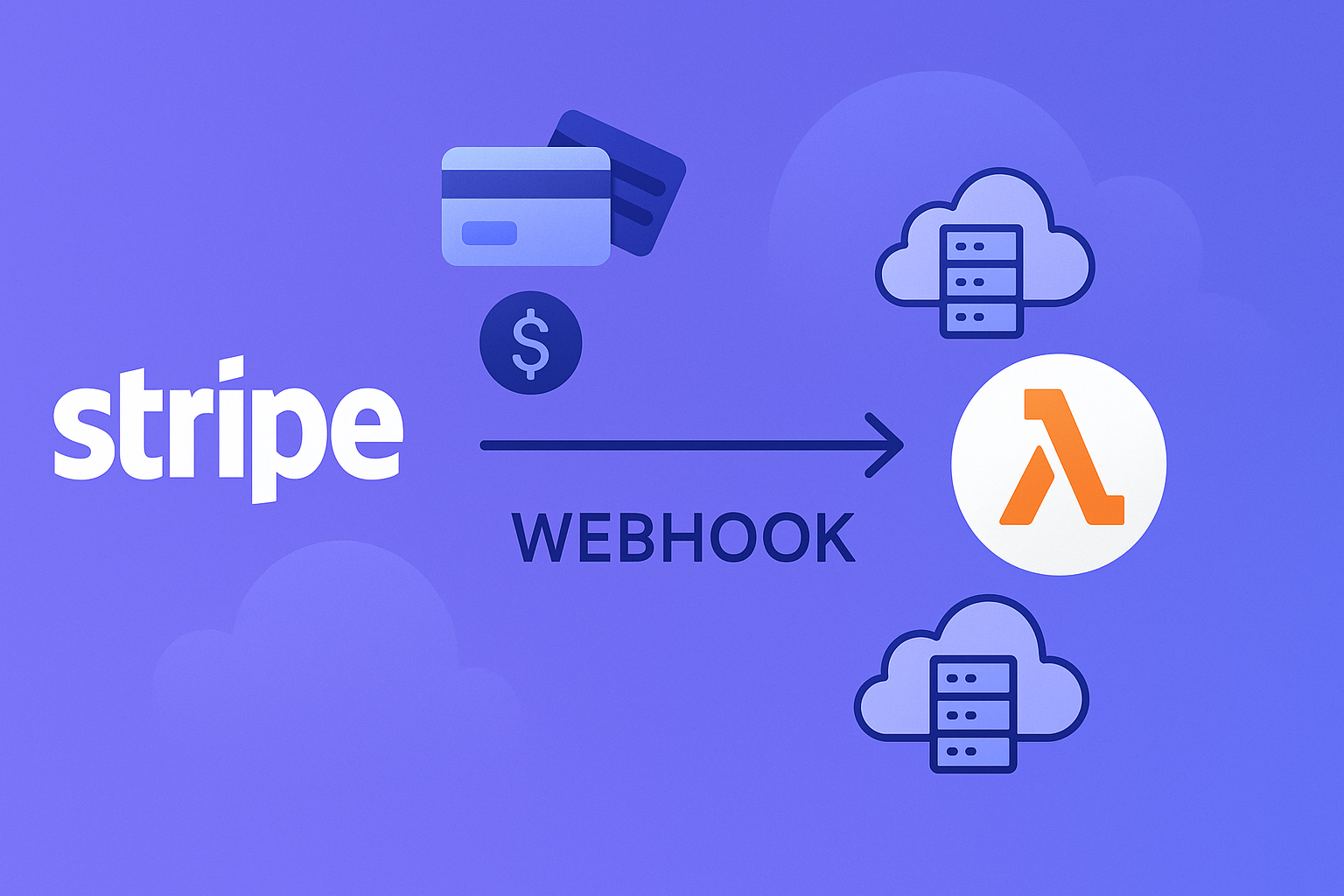How to Configure Stripe Webhooks for Your Serverless SaaS

Introduction
Stripe webhooks are essential for building reliable payment processing in your serverless SaaS application. They provide real-time notifications about payment events, ensuring your application stays synchronized with payment status changes without requiring manual intervention.
This tutorial focuses on implementing Stripe webhooks using AWS serverless services including AWS Lambda functions, API Gateway, DynamoDB, and AWS Secrets Manager. We'll walk through configuring webhook endpoints that automatically scale with your traffic while maintaining zero idle costs. If you're wondering why we reference Lambda functions and other AWS services, it's because we're building a complete serverless payment processing system on AWS.
In this comprehensive guide, we'll walk through configuring Stripe webhooks for a serverless architecture using AWS Lambda, including webhook verification, event handling, and best practices for secure payment processing automation.
This guide focuses on implementing Stripe webhooks in a serverless environment. If you're building a serverless SaaS with the Scale to Zero AWS Kit, webhook handling infrastructure is already pre-configured and ready to use.
What are Stripe Webhooks?
Stripe webhooks are HTTP callbacks that Stripe sends to your application when specific events occur in your Stripe account. Instead of repeatedly polling Stripe's API to check for changes, webhooks provide real-time notifications about important events like successful payments, failed charges, or subscription changes.
How Stripe Webhooks Work
Here's the typical webhook flow:
- Event Occurs: A customer completes a payment on your website
- Stripe Processes: Stripe processes the payment and updates the payment status
- Webhook Sent: Stripe immediately sends a webhook to your configured endpoint
- Your App Responds: Your application receives the webhook and updates user data accordingly
- Confirmation: Your app sends a 200 status code to confirm receipt
Why Webhooks Matter for SaaS Applications
Without webhooks, your SaaS application would face several challenges:
- Delayed Updates: Users might pay but not immediately get access to premium features
- Data Inconsistency: Your database might not reflect the actual payment status
- Poor User Experience: Customers could experience confusion about their payment status
- Manual Reconciliation: You'd need to manually match payments with user accounts
Benefits of Serverless Webhook Processing
Automatic Scaling
AWS Lambda automatically scales to handle webhook volume:
- High Traffic: Handles thousands of concurrent webhooks during peak periods
- Low Traffic: Scales to zero during quiet periods, saving costs
- Global Events: Processes webhooks from customers worldwide without capacity planning
Cost Efficiency
Serverless webhook processing offers significant cost advantages:
- Pay Per Use: Only pay for actual webhook processing time
- No Idle Costs: Zero charges when no webhooks are being processed
- Free Tier: AWS Lambda provides 1 million free requests per month
Processing 10,000 webhooks per month with an average execution time of 100ms would cost approximately $0.20 with AWS Lambda, compared to $30+ per month for a dedicated server.
Built-in Reliability
AWS Lambda provides enterprise-grade reliability:
- Automatic Retries: Built-in retry logic for failed webhook processing
- Dead Letter Queues: Failed webhooks are stored for manual review
- Multi-AZ Deployment: Webhooks are processed across multiple availability zones
Step-by-Step Stripe Webhook Configuration
Prerequisites
Before configuring Stripe webhooks, ensure you have:
- A Stripe account (test and live modes)
- A deployed serverless SaaS application with AWS Lambda
- AWS Secrets Manager access for storing sensitive keys
- A registered domain with SSL certificate
Step 1: Create Stripe Payment Links
First, let's set up payment links in your Stripe dashboard:
- Navigate to Payments: In your Stripe dashboard, go to
Payments→Payment links - Create New Link: Click
Create payment link - Add Product: Click
Add new productand fill in:- Product name (e.g., "Pro Plan Monthly")
- Price and billing frequency
- Product description
- Configure Link: Set up payment link options:
- Allow promotion codes
- Collect customer information
- Set up automatic tax calculation
- Create Link: Click
Create linkto generate your payment URL
Create separate payment links for each pricing tier (Starter, Pro, Enterprise) and billing frequency (monthly, yearly) to track conversion rates effectively.
Step 2: Set Up Webhook Endpoints
Now let's configure the webhook endpoint in Stripe:
- Navigate to Webhooks: Go to
Developers→Webhooksin your Stripe dashboard - Add Endpoint: Click
Add an endpoint - Configure URLs:
For Production environment:
https://api.yourdomain.com/v1/webhook/payment/stripe
For Development environment:
https://api.dev.yourdomain.com/v1/webhook/payment/stripe
- Select Events: Choose the events you want to receive:
checkout.session.completed- When a payment is successfulinvoice.payment_succeeded- For subscription paymentsinvoice.payment_failed- For failed recurring paymentscustomer.subscription.created- New subscription createdcustomer.subscription.updated- Subscription changescustomer.subscription.deleted- Subscription cancelled
Step 3: Webhook Security and Verification
Security is crucial for webhook endpoints. Stripe provides webhook signatures to verify that webhooks are actually coming from Stripe.
Adding Webhook Secrets to AWS Secrets Manager
-
Get Webhook Secret: In your Stripe webhook configuration, click
Revealunder theSigning secretsection -
Store in AWS Secrets Manager: Add the secret with the key:
stripeWebhookSecret=whsec_your_webhook_secret_here -
Add Stripe Secret Key: Also store your Stripe secret key:
stripeSecretKey=sk_test_or_sk_live_your_secret_key_here
Never hardcode secrets in your application code. Always use AWS Secrets Manager, and use different secrets for development and production environments.
Step 4: Webhook Processing Architecture
Here's how the serverless webhook processing works:
graph TD
A[Stripe Event] --> B[API Gateway]
B --> C[SQS Queue]
C --> D[Lambda Function]
D --> E[Verify Signature]
E --> F{Valid?}
F -->|Yes| G[Process Event]
F -->|No| H[Reject Request]
G --> I[Update DynamoDB]
I --> J[Add to Cognito Group]
J --> K[Send Emails]
K --> L[Return Success]
H --> M[Return Error]
Production Lambda Function Implementation
Here's the core webhook processing logic from our production system:
Webhook Signature Validation
const validateStripeWebhook = async (
rawBody: string,
headerSignature: string,
stripeSecret: { stripeSecretKey: string; stripeWebhookSecret: string }
) => {
const { stripeSecretKey, stripeWebhookSecret } = stripeSecret;
const stripe = new Stripe(stripeSecretKey, {
apiVersion: '2022-11-15',
typescript: true,
});
try {
stripe.webhooks.constructEvent(
rawBody,
headerSignature,
stripeWebhookSecret
);
return;
} catch (err) {
throw new Error(`Stripe signature verification failed: ${err.message}`);
}
};
Webhook Event Processing Best Practices
1. Event-Driven Architecture with SQS
Use SQS to decouple webhook receipt from processing. This provides automatic retries, dead letter queues, and handles traffic spikes gracefully.
2. Secure Signature Validation
Always verify webhook signatures using Stripe's webhook secret stored in AWS Secrets Manager. This ensures webhooks are actually from Stripe.
3. Idempotency with DynamoDB
Prevent duplicate processing by using Stripe event IDs as primary keys with conditional expressions:
// Use event ID to prevent duplicate processing
const PK = `ORD#${eventId}`;
const conditionExpression = 'attribute_not_exists(PK)';
await putTableItem(tableName, item, documentClient, conditionExpression);
Monitoring and Debugging Webhooks
CloudWatch Logging
Use structured logging with AWS request IDs for easy tracing:
- Log webhook events with context (event type, customer email, payment amount)
- Include AWS request IDs for distributed tracing
- Set up CloudWatch alarms for high error rates or slow response times
Stripe Dashboard Monitoring
Monitor webhook health directly in Stripe:
- Success Rate: Track delivery success percentage
- Response Times: Monitor endpoint performance
- Failed Attempts: Review and manually retry failed deliveries
Testing Strategy
- Test Mode First: Always test webhooks in Stripe test mode
- Use Test Cards: Complete purchases with Stripe test card numbers
- Verify Database: Check that user permissions and orders are created correctly
- Monitor Logs: Ensure CloudWatch shows successful processing
Common Webhook Issues and Solutions
Issue 1: High-Volume Events
Problem: Large numbers of simultaneous webhook events can overwhelm Lambda functions
Solution: Use SQS for buffering and batch processing. SQS automatically batches up to 10 records per Lambda invocation (by default) and provides built-in retry logic.
Issue 2: Duplicate Processing
Problem: Stripe may send duplicate webhook events
Solution: Use Stripe event IDs as DynamoDB primary keys with conditional expressions to prevent duplicate processing.
Issue 3: Complex User Onboarding
Problem: Multiple async operations (database updates, user permissions, email sending) can be slow
Solution: Use Promise.all() to execute operations faster, reducing total processing time.
Scale to Zero AWS Kit: Pre-Built Webhook Infrastructure
Building webhook processing from scratch requires significant development time and AWS expertise. The Scale to Zero AWS Kit provides production-ready webhook infrastructure that handles all the complexities we've discussed:
Pre-Built Features
✅ Webhook Verification: Automatic signature verification with AWS Secrets Manager
✅ Event Processing: Lambda functions for all major Stripe events
✅ Error Handling: Built-in retry logic and dead letter queues
✅ Idempotency: Prevents duplicate event processing
✅ Monitoring: CloudWatch dashboards and alarms
✅ Security: Best practices for webhook security
✅ Database Integration: Automatic user data updates in DynamoDB
✅ Email Notifications: Automated customer communications
Event-Driven Architecture
The kit includes a complete event-driven payment processing system:
- SQS Queues: Reliable webhook event queuing
- Lambda Processors: Dedicated functions for each event type
- DynamoDB Updates: Automatic user subscription management
- Email Automation: Customer notifications via AWS SES
Frequently Asked Questions
How do I handle webhook failures?
Stripe automatically retries failed webhooks with exponential backoff. Your endpoint should:
- Return 200 for successful processing
- Return 4xx for invalid requests (no retry)
- Return 5xx for temporary failures (will retry)
What happens if my webhook endpoint is down?
Stripe will retry failed webhooks for up to 72 hours. After that, you can manually replay missed events from the Stripe dashboard.
Can I process webhooks synchronously?
Yes, you can process webhooks synchronously. However, it's recommended to use a queue to ensure the webhook is processed in a timely manner.
How do I secure my webhook endpoints?
Always verify webhook signatures using Stripe's webhook secret. Never rely solely on the endpoint URL for security.
What's the difference between test and live webhooks?
Test webhooks use test data and test API keys, while live webhooks process real payments. Always test thoroughly in test mode before enabling live webhooks.
Conclusion
Configuring Stripe webhooks for your serverless SaaS application ensures reliable, real-time payment processing that scales automatically with your business growth. By implementing proper webhook verification, error handling, and monitoring, you can build a robust payment system that provides excellent user experience.
Key takeaways for successful webhook implementation:
- Security First: Always verify webhook signatures and store secrets securely
- Handle Failures: Implement proper error handling and retry logic
- Monitor Performance: Set up comprehensive logging and alerting
- Test Thoroughly: Test in both development and production environments
- Plan for Scale: Use serverless architecture for automatic scaling
Whether you're building webhook processing from scratch or using a pre-built solution like the Scale to Zero AWS Kit, following these best practices will ensure your payment processing is reliable, secure, and cost-effective.
The serverless approach to webhook processing provides the perfect balance of cost efficiency, automatic scaling, and reliability needed for modern SaaS applications.
Useful Resources
Related Blog Posts
- What is Scale to Zero? Build Your SaaS with Serverless Architecture
- Common Misconceptions about AWS Lambda
- AWS DynamoDB Data Modeling – Part 1
- Use UUIDv7 in DynamoDB to Save Money and Improve Performance
- Create Scheduled Tasks with AWS EventBridge Scheduler and Lambda
External Resources
- Stripe Webhook Documentation
- AWS Lambda Best Practices
- AWS Secrets Manager Documentation
- Stripe CLI for Local Testing
Next Steps
Ready to implement bulletproof webhook processing for your SaaS?
Get the Scale to Zero AWS Kit and deploy production-ready Stripe webhook infrastructure in minutes. The kit includes everything covered in this guide: webhook verification, event processing, error handling, monitoring, and detailed documentation.
